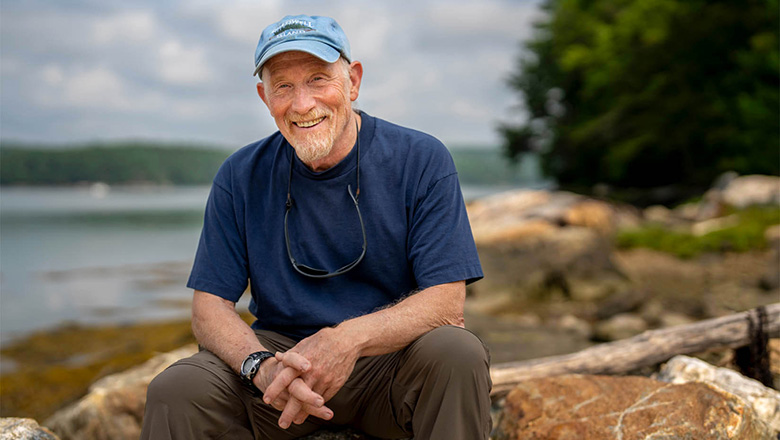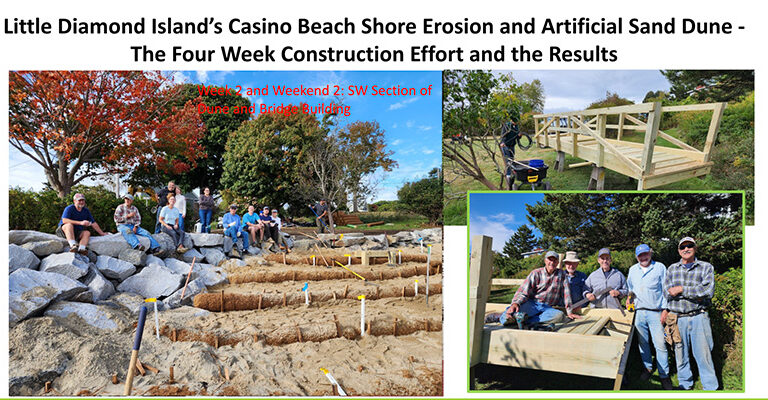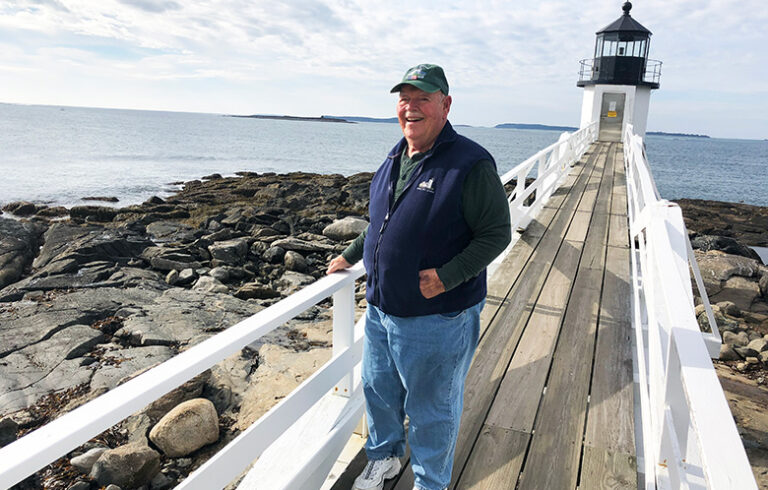Bob Steneck can now add to his already impressive resumé membership in the American Academy of Arts and Sciences. The work that led to that honor for the former University of Maine professor came from donning scuba gear and messing around with critters on the sea floor.
Steneck suspects it was his work studying coral reefs that earned him election to the prestigious Academy, which was established nearly 250 years ago. But in Maine, his in-the-water research on lobster helped bridge a gap between fishermen and regulators. And it helped the industry accurately predict future lobster landings, a critical component in keeping this important economic sector thriving.
The size-frequency distributions I was looking at … is what you would expect if you were going to be having a population explosion.
Steneck is the first UMaine faculty researcher to be elected to the Academy, where he joins Charles Darwin, Albert Einstein, and Jonas Salk.
Our conversation has been edited for length and clarity.
WW: What made you get interested in this field, in oceanography or marine biology or whatever you characterize the focus area?
Steneck: As far back as I can remember, I was always a naturalist. But I was also kind of a water baby. I started scuba diving when I was ten years old, in lakes. I spend a ton of time underwater, and I really liked that.
When I went to college, I was very interested in limnology [the study of freshwater biology] and did some projects in freshwater. During college, I went to a summer program for six weeks in St. Croix. Suddenly the diversity of the marine world, especially coral reefs, back then, when coral reefs were in really good shape, was very attractive.
I took a course from this fellow from the Smithsonian, and I did well in the course, I guess, and he asked if I wanted to be a technician when I graduated. He’s living on a 41-foot trimaran sailboat. He’s asking me if I want to study coral reefs in the Virgin Islands. That wasn’t really a very hard question to answer.
WW: So what year would that have been?
Steneck: So I took the course in ’72, and then I graduated in June of ’73, and a couple of days later I was in St. Croix.
WW: So the coral reef work began first?
Steneck: Yeah. My PhD. at John Hopkins involved the Caribbean, the Pacific Northwest, and Maine. My master’s thesis was all in Maine. I was looking at similarities in algal structure and herbivory under these entirely different systems, where there’s no species in common. So I’m really looking at ecological processes that drive these things. I got hired a month before I defended my dissertation by the University of Maine.
WW: Can we talk about lobster? [In other interviews] you’ve used the term “ecological approach.” Is that more systems based? Is that why it was more accurate in your assessments of the population?
Steneck: My first National Science Foundation grant when I came to the university was to study plant-herbivore interactions. So I was actually studying lipids and urchins and the algae they feed on. All my work was underwater—scuba, and later, submarine.
But I was noticing a lot of lobsters. So I went over the Department of Marine Resources and I said to the head lobster guy, “I’m seeing a lot of lobsters. That surprises me, because I know a lot of people fish for them.” And he rocked back in his chair, and said “No, actually, they’re not that abundant.”
I said, “No, wait a minute. I’m seeing them.” This is not a theoretical question.
That stimulated me to get into the library and look around. I realized nobody, zero, had been studying lobsters in their natural habitat.
Starting around 1983 or 1984, I found it super easy to write proposals saying I’m studying lobster in their natural habitat, going into fundamental questions like what do they eat, who eats them.
In about 1985, I took on Rick Wahle as a graduate student and he wanted to work on horse mussels, and I said, “We’re actually working on lobsters, but what we really need to know is, where do the babies come from?” Nobody knew that. Nobody knew where the nursery grounds were.
He figured out that at least 90% were settling into cobblestone habitats, which are only about 2% of the coastline. That’s really interesting. We found that if they didn’t fall into a cobblestone habitat, they’d be eaten within one to 15 minutes.
We started understanding how babies settled into the sea floor, how we could monitor settlement, how that could become an early warning system for the lobster landings. My biggest grant from Sea Grant was exactly that, looking for an early warning system. Rick was part of that study.
We started doing sea sampling. I was nominated for a Pew fellowship in marine conservation and my proposal was explicitly to install an ecological approach to fisheries management. And it involved not only understanding the distribution and abundance of lobsters, but also working directly with the lobstermen.
One of the first things I did, because I was curious about the role of lobster traps, was I went to the South Bristol Coop. I said, “I’m really interested in what the role of lobster traps is, and I’m really curious what would happen if you removed your traps from this area called the Thread of Life. And of course, they immediately broke out in laughter. I said, “It’s OK. I’m doing this via DMR (Department of Marine Resources), I’m just asking if this is OK with you. If you don’t want to do this, I’ll go to Pemaquid.”
One of the fellows, who was really well respected, Arnie Gamage, said “This sounds interesting.” At the time there was a growing interest in what the impact of all the lobster gear was. At that time, there was no limit on the number of traps that people could have.
WW: Was this the ‘80s still?
Steneck: Yeah, it was. It was like in 1985. I think I did it three years in a row. Every day we were diving and we had these grids on the sea floor, we were looking to see if lobsters were coming back to the same area to shelter, and the answer is they don’t. We were tagging all the lobsters in that area, realizing that early in life, they’re hardly moving at all, by the time they get to 60 millimeters on carapace, they might be going as far as 1 kilometer, less than a mile, and when they approach reproductive maturity they start going great distances, and at the time that wasn’t known.
And the lobstermen did remove the traps, and suddenly this became their project. I was going out with lobstermen, seeing what they were catching. At that time, there was a real big push to increase the minimum gauge, and the size-frequency distributions I was looking at, just measuring every lobster that I saw, is what you would expect if you were going to be having a population explosion.
But all the fisheries models based on what was landed said the probability of any lobster able to make it to reproduction size is vanishingly small. And what they didn’t realize, but what I was beginning to pick up on, was that lobsters were moving out of these shallow zones into deeper water as they got bigger. They were assuming all the decline was fishing mortality. A colleague was able to point out they had no sense of what the real mortality was, and because of that, they didn’t know what the trap mortality was. Their model wasn’t working the way they thought it would be.
We started setting up areas—York, South Bristol, around Mount Desert Island, and roughly from Isle au Haut to Winter Harbor, and Jonesport. And we learned was that population densities were much higher in western Maine than eastern Maine.
My Pew proposal, in the 1990s, was to go for an ecological approach and I decided to fund a single student for his entire degree. And the student that I picked was an intern with me named Carl Wilson [now the commissioner of DMR].
Not only was he the son of Jim Wilson, who had worked with fishing communities forever, but Carl really knew a lot about fishing boats and he connected very well, his sister Karen was able to figure out that 80% of all the lobsters are settling in the upper 60 feet of water. And that’s really important. It means we were getting a demographic signal in shallower water where we were scuba diving which would give us some information about a future population.
Using the American Lobster Settlement Index and sea-sampling, both with vented traps and ventless trap, along with looking at landings, and, in 2000, they started looking at inshore groundfish trawls.
All those things are how Maine integrated an ecological approach to lobster fisheries management.
WW: I mean it’s surprising that it took that much effort that recently to add that approach, which is obviously much more sophisticated, yet it’s sort of intuitive, rather than just looking at landings.
Steneck: I think it is. But the marine ecological community, for a long time, starting in the early ’70s, started realizing the importance of the recruitment of species. They call it “supply side ecology.” Prior to that, everyone was looking at competition and predation among adults, and then they started realizing that the real demographic driver is how many babies survive on the sea floor.
WW: What do you see as the future of lobster now? Not to put you on the spot…
Steneck: It’s a super interesting challenge. My last Ph.D. student, Robert Jarrett, is just finishing up a lobster study. And he’s showing that not only has the abundance of lobsters at our monitoring sites, sites that I’ve been monitoring since the 1980s, were high, but declined in recent years.
Water is getting warmer, so there’s likely to be less oxygen in warmer water, there’s a lot more algae on the sea floor because urchins are no longer there. Could there be more rotting seaweed creating hypoxia and anoxia, and that’s causing the lobsters not to want to go into these shelters?
We don’t entirely understand why, but what we do know is that settlement has been declining well over a decade. Now it’s showing up in the traps. The highest landings we ever had in terms of tonnage was in 2016. With a couple of ups and downs, it’s been downward since then.
What we don’t know is how low it’s going to go. That the reason why I still think it’s an important question to try to understand why we’re seeing this pattern. There are a number of possibilities, including warming water changing zooplankton communities.
But also these changes that are going on in the Northeast Channel. Forever, it was coming in from the Scotian Shelf, the Labrador Current would come in, it would have high salinity, it would plunge under the Gulf of Maine water and it would settle into the deep water. But then, in increasing frequency, there’s warm water coming in there, low in nutrients. But there really hasn’t been a decline in reproductive lobsters.
It’s not like we don’t have the mothers out there. We have mothers, we have eggs, they’re developing, why aren’t we seeing settlement?
WW: And there aren’t any new predators that have entered the scene.
Steneck: No, more the reverse. Black sea bass have increased, but almost all the other predators, the cod, hake, halibut are showing significant declines in landings and in-shore trawl data.
WW: Right. So obviously, it’s a lot more complicated than the shorthand, which is that the waters are warming and they’re moving north and east.
Steneck: Lobsters are not migrating from Midcoast Maine to Nova Scotia. Back when I did that first study in the 1980s, where almost all the settlement was in western Maine, with the warming, lobster larvae are very sensitive to cold temperatures. So if they start diving down and hit water temperatures that are too cold, they turn around and go back up. This was first found by a Canadian scientist.
As water temperatures warmed in eastern Maine, given the big tides you have there, it mixes all the way down to the sea floor. There was a huge expansion of nursery habitat, which is why eastern Maine in the last 20 years has been the zone of by far the greatest increase in lobster landings.
WW: What do you think is the biggest threat to the Gulf of Maine?
Steneck: I am genuinely concerned about the maritime heritage of the coast of Maine. It goes back to before the Europeans got here. The first people to come to the coast were fish eaters.
We’ve seen this sequential decline of groundfish. Everybody knows this. And to a degree, the loss of predators was to the advantage of lobsters, but remember, if you don’t have the settlers, it doesn’t matter that you don’t have any predators.
I’m really worried about the livelihoods. Maine is one of the few places in North America where fishing communities can live close to the ocean. I’ve been working in the Dominican Republic, and the entire coastal zone has been gentrified. You go 20 miles inland and people are living in abject poverty.
I really worry about the number of people buying up land. If fishing coops can’t make it, people will gobble up that dock space. Working waterfront are at risk.
WW: Finally, of what are you most proud in your career?
Steneck: I think my students. People like Susie Arnold [senior marine scientist at Island Institute]. Carl Wilson [commissioner of DMR] did very well, Rick did very well setting up the Lobster Institute. I think those are lasting impacts. I’m very proud of those.
WW: I was struck by the way you brought fishermen into the loop and gathering data and driving public policy. It just seems like it didn’t happen before you did it.
Steneck: When I asked those guys in South Bristol to remove their traps, and they agreed… As a matter of fact, there was one guy who was not a member of that coop, and he didn’t want to remove his traps. I didn’t have to talk to him. One of the local guys said to him, “I’d hate to see anything happen to your traps.” I didn’t say that. I pretended I didn’t hear that. The next day he took all his traps out.
Then, all the lobstermen started coming by and asking how their project was going. That was very interesting.





